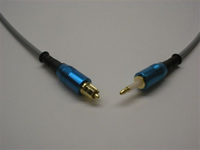- AccurateRip
- Acoustid
- AES/EBU
- AirPlay
- Amplifier
- aptX
- Audio file formats
- ASRC
- AVB
- Bit perfect jitter
- Bits: 16 or 24
- Bit perfect playback
- Bitrate
- Bluetooth
- Burn-in
- BWF
- Cables
- CDtext
- Chromecast
- Clipping
- Clock
- Codec
- Compression
- CRC
- Crossover
- Cue sheet
- DAC
- Damping
- DASH
- Digital
- Digital Room Correction
- Dither
- DLNA
- Drivers
- DoP
- DSP
- EBU R128 (loudness)
- FFT
- FireWire
- Freedb
- Gapless playback
- Generation loss
- HDMI
- Headphone listening
- Hearing
- Hires recording
- Homeplug
- I2S
- ID3
- Inter sample peak
- LDAC
- Linearity (DAC)
- Memory playback
- Music Server
- OCF
- OFC
- PCM
- Perception
- RAID
- ReplayGain
- Ripping
- RFI
- RIAA
- Router
- Sampling, up and over
- Sample Rate Conversion
- Speakers
- S/PDIF
- Storage
- Sync
- Tagging
- Toslink
- Transcoding
- UAA
- Units
- UPnP
- USB
- VST
- WiFi
- WiSA
Toslink
Toshiba created TOSLINK (1983) to connect their CD players to their receivers. It was soon adopted by manufacturers of most CD players. Using light it is immune RFI and EMI and the devices are completely electrically separated.
Toslink (EIAJ optical) is SPDIF over optical.
The light source is a simple and inexpensive LED.
Toslink cables are made of plastic or glass.
The plastic ones are cheaper but have a higher attenuation coefficients (1 dB/m or higher).
Due to the high attenuation, reliable transmission distances were limited to 10 meters, in practice often under 5 meters.
Today companies like Lifatec offers length up to 30 m (98 ft.) using APF (All Plastic Fiber) with an attenuation (optical loss) less than 0.15dB/m.
Today the program is not limited to audio only.
The general purpose modules offer a bandwidth up to 6 Mb/s over 40 m using APF.
The digital audio modules allow for 15 Mb/s.
One should expect Toslink perform better than SPDIF over coax as the components are fully electrical isolated.
Optical out (TosLink) provides great isolation from the RFI of the computer. (You will still want to put a power line filter on the computer to keep the RFI from its switching power supply out of the rest of your system.)
The problem with TosLink is that it is S/PDIF, which inherently adds jitter. The faster the rise time of the data link, the less jitter gets added. TosLink is pretty slow and the rise times are slow enough that it can barely handle the data rates for S/PDIF. So there is more jitter added than with a coaxial cable. Therefore TosLink is better than coax in one way and worse in another.
The end result will depend on how well your external DAC rejects jitter. Unfortunately there is no such thing as an S/PDIF DAC that completely rejects jitter, except for the Chord. It has a big buffer and it takes 4 seconds after you hit play before you hear music.
Charles Hansen (2009)
Most audiophiles are convinced that Toslink sucks.
But technology has improved since it’s debut (1983).
Maybe this is “evidence from the absurd” but if even a typical audiophile site like SixMoons has problems to hear any difference between coax and Toslink cables, one might wonder if Toslink is inferior to coax today.
This subject is covered in Toslink or Coax.
Performance
Today Toshiba audio modules have a Data Rate up to 15 Mb/s (NRZ=Non-return-to-zero)
If we run SPDIF:
| Sample rate | 96000 | Hz |
| Word length | 32 | Bit |
| Channels | 2 | Stereo |
| biphase-mark-code | 2 | Twice the sample rate |
| 12288000 | bit/s | |
| 12.288 | Mb/s |
96 kHz 2 channel audio can be done using Toslink.
24 bit / 96 kHz 2 channel audio is indeed the maximum the Toslink standard allows for.
Modern hardware often beforms better than the standard.
24 bit /176 might work.

You won't find many computers with Toslink.
Apple and Toshiba are exceptions to this rule.If Mohammed will not come to the mountain, the mountain will go to Mohammed.
That is exactly what happened, as the audio industry most of the time offers legacy SPDIF connectivity instead of USB, especially the multimedia PC's close the gap by offering SPDIF over optical or electrical.

